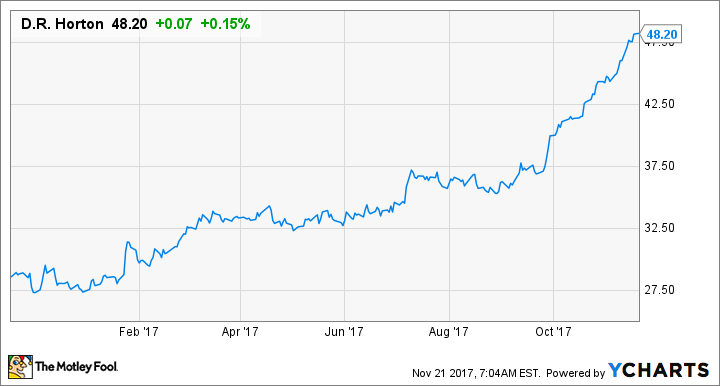D.R. Horton Delivers Another Round of Higher Profits in Q4
2017 has been a great time to be a homebuilder, and even better for the nation's largest homebuilder, D.R. Horton (NYSE: DHI). The company delivered another quarter of improving results that puts it close to producing pre-housing crash revenue results, and that was even in the face of Hurricanes Harvey and Irma.
Here's a look at the company's most recent results and what investors can expect in the coming quarters.

Image source: Getty Images.
By the numbers
Metric | Q4 2017 | Q3 2017 | Q4 2016 |
|---|---|---|---|
Revenue | $4.07 billion | $3.78 billion | $3.65 billion |
Gross profit* | $802.5 million | $723.4 million | $732.6 million |
Net income | $313.2 million | $289.0 million | $283.6 million |
Diluted EPS | $0.82 | $0.76 | $0.75 |
*Does not include financial services income. Data source: D.R. Horton earnings release. EPS = earnings per share.
For D.R. Horton, the good times keep on rolling. Up and down the income statement and operating metrics tables, the company delivered better numbers. Total net new orders increased 11.8% to 10,333 units, total closings rose 7.5% to 13,165, total backlog value increased 8.3% to $3.73 billion, and the company maintained low SG&A costs of 8.6% of total revenue.
What is perhaps the most surprising about these results is the company was able to deliver those better numbers even though Hurricanes Harvey and Irma affected its two largest regions. This is one of D.R. Horton's largest advantages as its nationwide footprint allows it to offset any weakness in one or two regions.
Market | Total Homes Closed | YOY Growth | Total Home Value | YOY Growth |
|---|---|---|---|---|
East | 1,710 | 9.7% | $478.7 million | 7.1% |
Midwest | 552 | 10.6% | $214.5 million | 15% |
Southeast | 4,209 | 5.4% | $1.09 billion | 7% |
South Central | 3,497 | (1.5%) | $880.6 million | 1% |
Southwest | 861 | 39.1% | $194.5 million | 37.5% |
West | 2,336 | 15.3% | $1.17 billion | 20.9% |
Total | 13,165 | 7.5% | $4.03 billion | 10.9% |
Data source: D.R. Horton earnings release. YOY = year over year.
As this was the end of the fiscal year for D.R. Horton, the company gave its fiscal 2018 outlook. Here are some of the highlights:
Revenue of $15.5 billion to $16.3 billion.
Homes closed between 50,500 and 52,500.
Pre-tax profit margin of 11.5% to 11.7%.
Cash flow from operations (excluding the impact from its investment in Forestar Group) of $500 million.
What management had to say
Here's Chairman Donald R. Horton giving a quick recap of the year and some of the objectives for the coming year:
Our consolidated pre-tax income increased 18% to $1.6 billion on revenues of $14.1 billion, and our consolidated pre-tax profit margin improved 30 basis points to 11.4%. Our homebuilding return on inventory improved 120 basis points from a year ago to 16.6%. Cash flow provided by operations was $435.1 million in fiscal 2017, totaling $1.8 billion for the past three fiscal years.
These results reflect the strength of our experienced operational teams, industry-leading market share, broad geographic footprint and diverse product offerings across our D.R. Horton, Emerald Homes, Express Homes and Freedom Homes brands. We remain focused on growing our revenues and pre-tax profits at a double-digit annual pace, while continuing to generate positive annual cash flows and improved returns. With 26,200 homes in inventory at the end of the year, 249,000 lots owned and controlled, and positive sales trends in October, we are excited and well-positioned for continued strong performance in 2018 as we celebrate our 40th anniversary year.
What a Fool believes
With so many other companies doing incredibly well during this market upturn, it can be hard to tell which companies are doing well by virtue of a market upturn or from management execution. For D.R. Horton, it's probably a bit of both. The company has a large and diverse geographic footprint that helps the company overcome challenges like the recent hurricanes that affected results for its communities in Texas and Florida. Management has also done well to keep its overhead costs low and improve return on inventory -- a measure of profitability based on its inventory of properties.
At the same time, though, one has to wonder if the company will be able to make similar strides when the housing market eventually cools off. For all of its accomplishments of lowering inventory, it still has an immense amount of money tied up in working capital, and its free cash flow conversion isn't that great. Hopefully, the company can continue to make strides to improve its inventory such that it can improve its cash-flow-generating abilities.
More From The Motley Fool
6 Years Later, 6 Charts That Show How Far Apple, Inc. Has Come Since Steve Jobs' Passing
Why You're Smart to Buy Shopify Inc. (US) -- Despite Citron's Report
Tyler Crowe has no position in any of the stocks mentioned. The Motley Fool has no position in any of the stocks mentioned. The Motley Fool has a disclosure policy.

